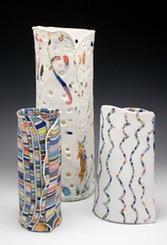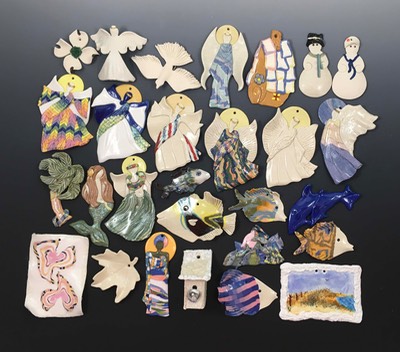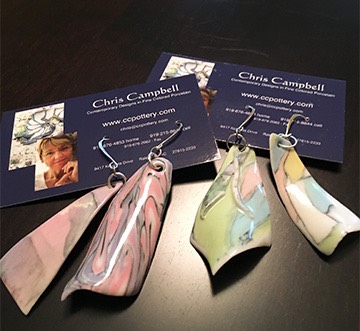While isolating at home during the Covid pandemic, I was able to create a series of 8 videos which together are a basic Colored Clay Workshop.
Introduction to Colored Clay – Video Table of Contents
Video #1 – Introduction
59:00 minutes
Choosing Clay - How to choose your clay body
Stain Information - How to choose your stains
Mixing Stains into Clay Coloring clay with stains
Mixing Stains into Slip - Coloring slips with stains
Color Test Discs - Making color test discs
Video # 2- Skinner Blends
57:00 minutes
Traditional method - Original method of mixing secondary colors
Two Color Skinner Blend - An easier way of blending secondary colors
Multiple Color Blend - Multiple colors in one Skinner Blend sheet
Test Strip - Making a test strip for every Skinner Blend
Optional Placements - Various ways to place your colors
Color on both sides - Solving a color problem
Brightening - Adding white to brighten the Blend
Other Placement Options - More color placement options
Single Color Fade - Single color with white Blend
Test Strip – fired - Judging your colors with bisque test strips
Recommended Tools - Tools you might need
Making Cut Off Wire - Making your special cut off wire
Video # 3 – Stripes
1:00 hour
Basic Stripe Cane - Making striped canes with Skinner blends
White & color stripes - Adding white to lighten the color effect
Vary thickness & patterns - Optional choices in stripe designs
Accordion fold stripes - Soft, wavy stripes
Using the color blend - Using the whole width of the blend
Precise patterns - Using firmer clay for precise patterns
Very thin stripes - Making very thin stripes
Video # 4 – Checked Patterns
1 hour 13 minutes
Precise Checked Cane - Precise checked patterns
Precise thin checks - Precise thin checked pattern
Basic Checked Cane - Basic method of making a checked pattern
Adding white detail - Adding white layers to cane patterns
Moving colors in patterns - How to fix checked patterns
Varied thicknesses - Vary the thickness for design interest
Mixing pattern sizes - Using varied sizes of the same pattern
Zig Zag patterns - Adding movement to your canes
Color in place patterns - Making checks without shifting basic colors
Free Form pattern - Re-purposing an existing cane
Video # 5 – Herringbone Patterns
1hour 23 minutes
Basic Herringbone - How to create a herringbone pattern
Optional design additions - Adding interest to basic designs
Leaf patterns - Making a leaf from a simple cane
Leaf Canes - Making and sizing leaves
Herringbone Creations - Making images from herringbone patterns
Video # 6 – Bullseye/Jellyroll Canes
1 hour 37 minutes
Basic Bullseye Cane - How to make a Bullseye cane
Abstract Design - Abstract pattern made with a Bullseye cane
Basic Jellyroll Cane - How to make a Jellyroll cane
Jellyroll cane options - Multiple ways to vary your cane design
Adding a color interior - Adding a sheet of color for design interest
Center of flower - Making the core of your flowers
Simple Flower Cane - A basic way of creating a flower cane
Flower with color changes - Progressive color changes in cane
Lilies - Making lily shaped flowers
Four square design - Making a contemporary design
Another flower design - A very simple technique
Static Cane - Contemporary design technique
Video # 7 – Hand Building with Colored Clay Canes
1 hour 35 minutes
Support forms - Bisque support system for building and firing
Math of shrinkage - How to calculate the size of the forms
Holding Area for clay - Store your pieces for even humidity
My Work Surface - Preparing my work area & patterns
Colored Clay Bowl - Slice & prep the canes
Laying out the pattern - Laying out your design & rolling to join
Making the bowl - Placing the sheet of color in the form
Wrap for drying - Careful wrapping for drying
Colored Clay Tray - Tray with handles
Basic Lamination Process - Basic process of lamination
Preparing thin color sheets - Colored sheet prep for bowl and tray
Laminated bowl & tray - Laminated bowl & Tray assembly
Creating a Quilt Pattern - Creating a quilt from small pieces
Laminating both sides - Laminating both sides with same pattern
VIDEO #8 – Dry, Clean, Glaze, Fire
1 hour 37 minutes
Drying your work - How to dry your colored clay Artwork
Marking your support form - Mark your forms for exact placement
One side at a time - Dry the piece before cleaning reverse
Cleaning the back - Support to clean reverse side
Talk about firing temps - How & why I fire my work
Cleaning bisque - Wet sanding
Wax resist - Applying wax resist
Glazing - Glazing for high fire
High Fire / Witness cones - Why use witness cones?
Controlled Cool - Firing down an electric kiln
Finished Artwork - Checking glaze results
Closing Remarks



